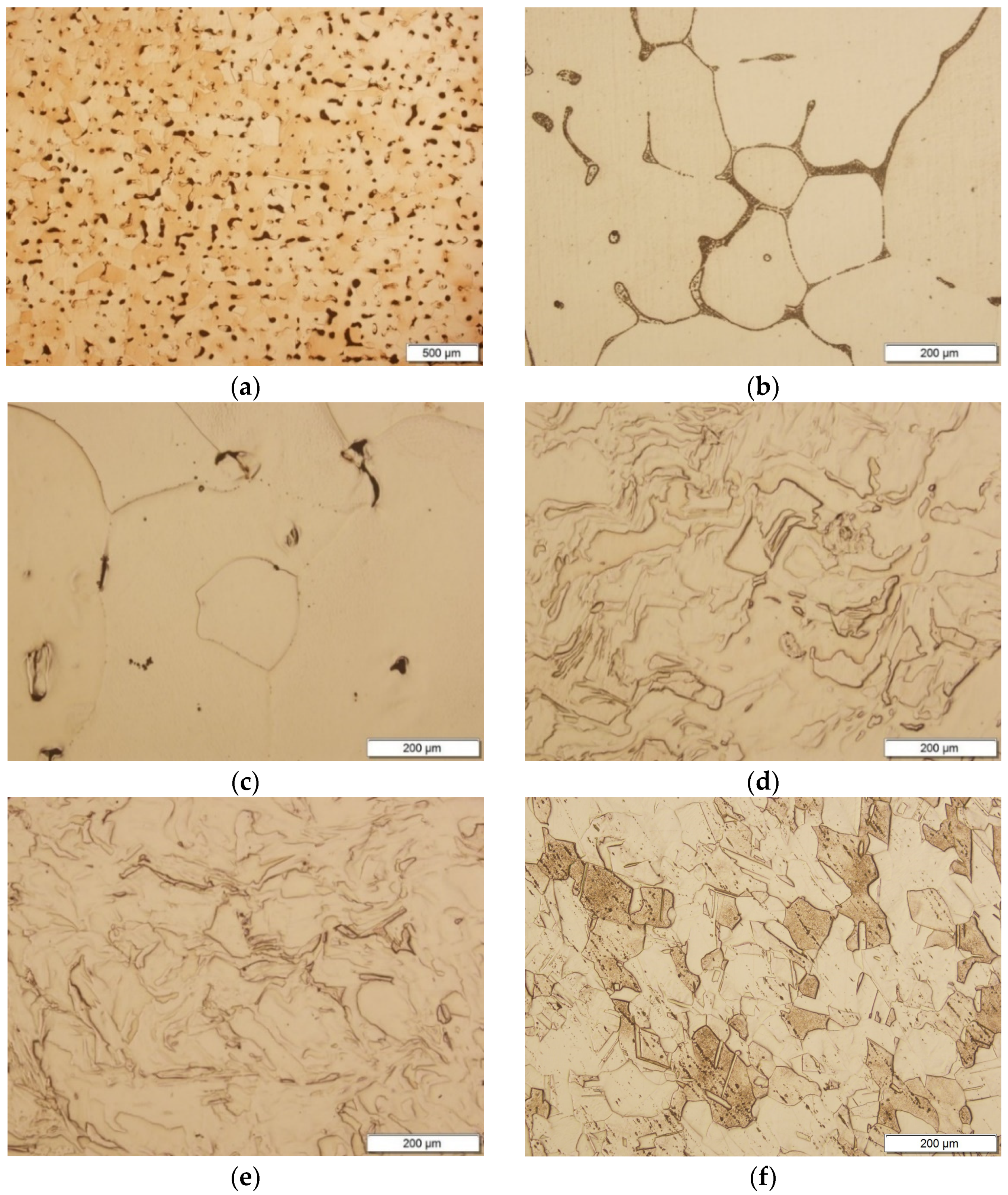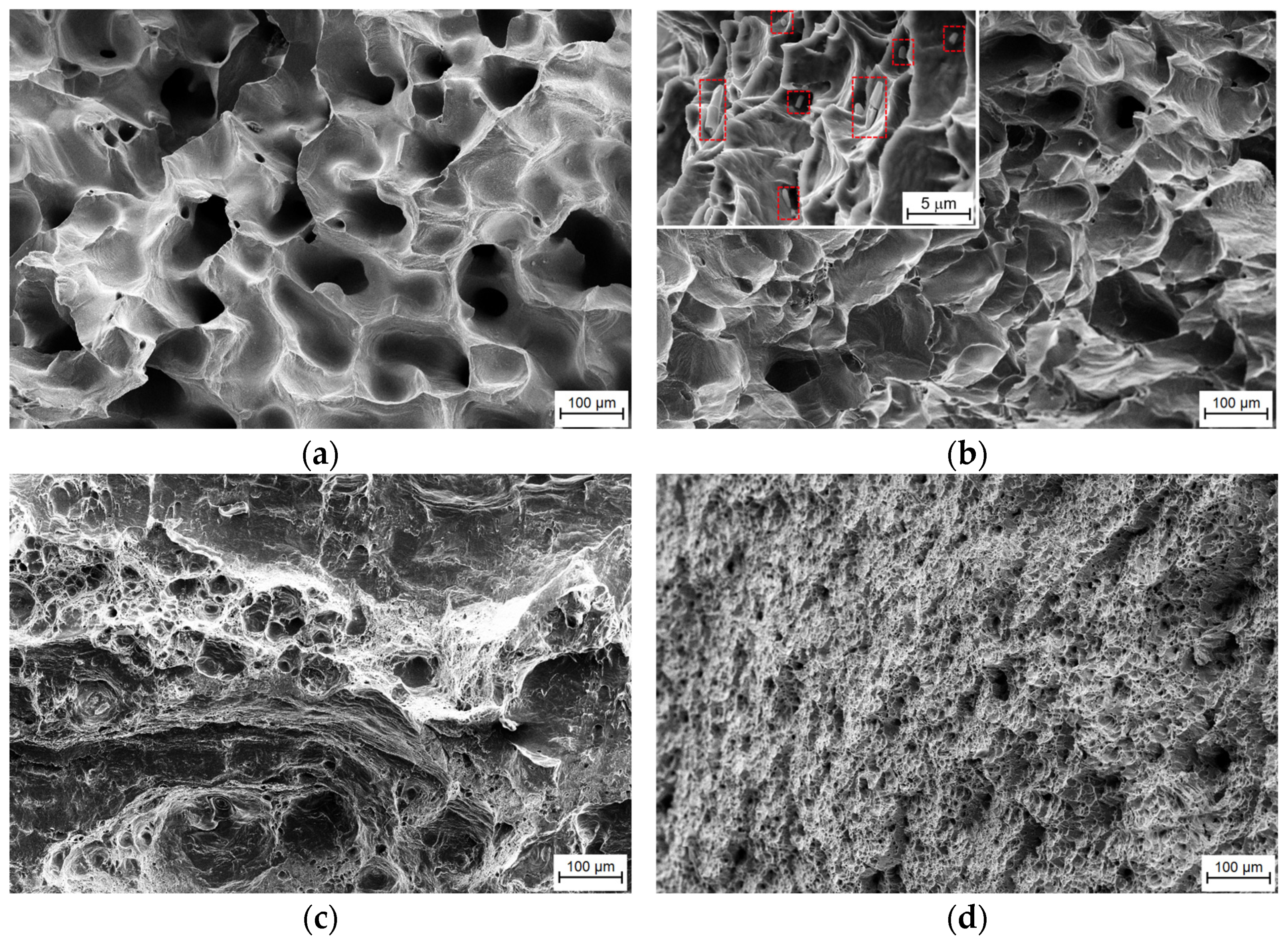Comparative Studies of the Properties of Copper Components: Conventional vs. Additive Manufacturing Technologies
Abstract
:1. Introduction
2. Materials and Methods
3. Results and Discussion
3.1. Surface Appearance
3.2. Microstructure
3.3. Specific Density
3.4. Oxygen Content
3.5. Mechanical Properties
3.6. Electrical Conductivity
3.7. Fracture Characteristics
4. Conclusions
- From the point of view of applications in the power and electronics industries, it is extremely important to emphasize the very good results of electrical conductivity obtained for components made by means of DMLS technology (>98.5% IACS), which are slightly lower than the value obtained for the reference sample.
- DMLS technology led to a very good homogeneity and no microstructural defects, which is related to the very high values of the relative density.
- Particularly noteworthy is the observed hardening present in the DMLS component after printing (at the level of material in the H80 state of hardening); therefore, DMLS technology provides properties that exceed the properties of components produced by sand casting.
- In the case of BJ printed, it was possible to obtain a part with a low oxygen content; however, the mechanical and electrical properties were not sufficient.
- The presented results are especially crucial for selection of the 3D-copper-printing method in the area of electrification, where rated operational voltages and currents are extremely high, and the manufactured electrical contact elements should ensure long-lasting and durable functionality in order to avoid the malfunctioning of switching and protection devices.
Supplementary Materials
Author Contributions
Funding
Data Availability Statement
Conflicts of Interest
References
- Jiang, Q.; Zhang, P.; Yu, Z.; Shi, H.; Wu, D.; Yan, H.; Ye, X.; Lu, Q.; Tian, Y. A Review on Additive Manufacturing of Pure Copper. Coatings 2021, 11, 740. [Google Scholar] [CrossRef]
- Sun, C.; Wang, Y.; McMurtrey, M.D.; Jerred, N.D.; Liou, F.; Li, J. Additive manufacturing for energy: A review. Appl. Energy 2021, 282, 116041. [Google Scholar] [CrossRef]
- Stavropoulos, P.; Foteinopoulos, P.; Papacharalampopoulos, A.; Bikas, H. Addressing the challenges for the industrial application of additive manufacturing: Towards a hybrid solution. Int. J. Lightweight Mater. Manuf. 2018, 1, 157–168. [Google Scholar] [CrossRef]
- Zhou, L.; Miller, J.; Vezza, J.; Mayster, M.; Raffay, M.; Justice, Q.; Al Tamimi, Z.; Hansotte, G.; Sunkara, L.D.; Bernat, J. Additive Manufacturing: A Comprehensive Review. Sensors 2024, 24, 2668. [Google Scholar] [CrossRef] [PubMed]
- Selema, A.; Ibrahim, M.N.; Sergeant, P. Metal Additive Manufacturing for Electrical Machines: Technology Review and Latest Advancements. Energies 2022, 15, 1076. [Google Scholar] [CrossRef]
- Mooraj, S.; Qi, Z.; Zhu, C. 3D printing of metal-based materials for renewable energy applications. Nano Res. 2021, 14, 2105–2132. [Google Scholar] [CrossRef]
- Yan, X.; Chang, C.; Dong, D.; Gao, S.; Ma, W.; Liu, M.; Liao, H.; Yin, S. Microstructure and mechanical properties of pure copper manufactured by selective laser melting. Mater. Sci. Eng. A 2020, 789, 139615. [Google Scholar] [CrossRef]
- Ladani, L.; Sadeghilaridjani, M. Review of Powder Bed Fusion Additive Manufacturing for Metals. Metals 2021, 11, 1391. [Google Scholar] [CrossRef]
- Vafadar, A.; Guzzomi, F.; Rassau, A.; Hayward, K. Advances in Metal Additive Manufacturing: A Review of Common Processes, Industrial Applications, and Current Challenges. Appl. Sci. 2021, 11, 1213. [Google Scholar] [CrossRef]
- Ngoa, T.D.; Kashania, A.; Imbalzanoa, G.; Nguyena, K.T.Q.; Hui, D. Additive manufacturing (3D printing): A review of materials, methods, applications and challenges. Compos. Part B Eng. 2018, 143, 172–196. [Google Scholar] [CrossRef]
- Gokuldoss, P.K.; Kolla, S.; Eckert, J. Additive Manufacturing Processes: Selective Laser Melting, Electron Beam Melting and Binder Jetting—Selection Guidelines. Materials 2017, 10, 672. [Google Scholar] [CrossRef] [PubMed]
- Ahmadi, M.; Bozorgnia Tabary, S.A.A.; Rahmatabadi, D.; Ebrahimi, M.S.; Abrinia, K.; Hashemi, R. Review of selective laser melting of magnesium alloys: Advantages, microstructure and mechanical characterizations, defects, challenges, and applications. J. Mater. Res. Technol. 2022, 19, 1537–1562. [Google Scholar] [CrossRef]
- Azami, M.; Siahsarani, A.; Hadian, A.; Kazemi, Z.; Rahmatabadi, D.; Kashani-Bozorg, S.F.; Abrinia, K. Laser powder bed fusion of Alumina/Fe–Ni ceramic matrix particulate composites impregnated with a polymeric resin. J. Mater. Res. Technol. 2023, 24, 3133–3144. [Google Scholar] [CrossRef]
- Mohsan, A.U.H.; Wei, D. Advancements in Additive Manufacturing of Tantalum via the Laser Powder Bed Fusion (PBF-LB/M): A Comprehensive Review. Materials 2023, 16, 6419. [Google Scholar] [CrossRef] [PubMed]
- Zhang, Y.; Li, Y.; Song, M.; Li, Y.; Gong, S.; Zhang, B. TiAl Alloy Fabricated Using Election Beam Selective Melting: Process, Microstructure, and Tensile Performance. Metals 2024, 14, 482. [Google Scholar] [CrossRef]
- ISO/ASTM 52900:2021-11; Additive Manufacturing—General Principles—Fundamentals and Vocabulary. ISO: Geneva, Switzerland, 2021.
- Tran, T.Q.; Chinnappan, A.; Kong Yoong Lee, J.; Huu Loc, N.; Tran, L.T.; Wang, G.; Kumar, W.V.; Jayathilaka, V.A.; Ji, D.; Doddamani, M.; et al. 3D Printing of Highly Pure Copper. Metals 2019, 9, 756. [Google Scholar] [CrossRef]
- Singer, F.; Deisenroth, D.C.; Hymas, D.M.; Dessiatoun, S.V.; Ohadi, M.M. Additively Manufactured Copper Components and Composite Structures for Thermal Management Applications. In Proceedings of the 16th IEEE Intersociety Conference on Thermal and Thermomechanical Phenomena in Electronic Systems (ITherm), Orlando, FL, USA, 30 May–2 June 2017. [Google Scholar] [CrossRef]
- El-Wardany, T.I.; She, Y.; Jagdale, V.N.; Garofano, J.K.; Liou, J.J.; Schmidt, W.R. Challenges in Three-Dimensional Printing of High-Conductivity Copper. Mater. Sci. J. Electron. Packag. 2018, 140, 020907. [Google Scholar] [CrossRef]
- Ziaee, M.; Crane, N.B. Binder jetting: A review of process, materials, and methods. Addit. Manuf. 2019, 28, 781–801. [Google Scholar] [CrossRef]
- Gong, G.; Ye, J.; Chi, Y.; Zhao, Z.; Wang, Z.; Xia, G.; Du, X.; Tian, H.; Yu, H.; Chen, C. Research status of laser additive manufacturing for metal: A review. J. Mater. Res. Technol. 2021, 15, 855–884. [Google Scholar] [CrossRef]
- Gerapid High Speed DC Breakers 2600–8000 A. Available online: https://library.industrialsolutions.abb.com/publibrary/checkout/170131_EN?TNR=Brochures%7C170131_EN%7CPDF&filename=170131_EN.pdf (accessed on 5 August 2024).
- Sinico, M.; Cogo, G.; Benettoni, M.; Calliari, M.; Pepato, A. Influence of Powder Particle Size Distribution on The Printability of Pure Copper For Selective Laser Melting, Solid Freeform Fabrication 2019. In Proceedings of the 30th Annual International Solid Freeform Fabrication Symposium—An Additive Manufacturing Conference Reviewed Paper, Austin, TX, USA, 12–14 August 2019. [Google Scholar]
- Huang, J.; Yan, X.; Chang, C.; Xie, Y.; Ma, W.; Huang, R.; Zhao, R.; Li, S.; Liu, M.; Liao, H. Pure copper components fabricated by cold spray (CS) and selective laser melting (SLM) technology. Surf. Coat. Technol. 2020, 395, 125936. [Google Scholar] [CrossRef]
- Kumar, A.Y.; Bai, Y.; Eklund, A.; Williams, C.B. The effects of Hot Isostatic Pressing on parts fabricated by binder jetting additive manufacturing. Addit. Manuf. 2018, 24, 115–124. [Google Scholar]
- Kumar, A.Y.; Wang, J.; Bai, Y.; Huxtable, S.T.; Williams, C.B. Impacts of process-induced porosity on material properties of copper made by binder jetting additive manufacturing. Mater. Des. 2019, 182, 108001. [Google Scholar] [CrossRef]
- Guschlbauer, R.; Momeni, S.; Osmanlic, F.; Körner, C. Process development of 99.95% pure copper processed via selective electron beam melting and its mechanical and physical properties. Mater. Charact. 2018, 143, 163–170. [Google Scholar] [CrossRef]




| Sample Name | Manufacturing Technology | Materials Used | Manufacturing Conditions |
|---|---|---|---|
| BJ | Binder Jetting | Copper powder: Cu > 99.95%, C = 0.03%, Fe = 0.01%; d50 = 44 μm | Metal printing with ExOne X1 25Pro (ExOne, North Huntingdon, PA, USA) printer: layer thickness: 50 µm, organic additive: water-based polymer binder (curing temp. 180 °C), sintering temp.: 840–900 °C |
| SC | Sand Casting | Oxygen-free copper (O2 < 0.001%) in form of wire | Sand mould printed with ExOne S-Max (ExOne, North Huntingdon, PA, USA) printer: FS001 quartz sand with size: 0.13–0.14 mm, layer thickness: 0.28 mm, furan binder. Copper casting temp.: 1085 °C |
| DMLS | Direct Metal Laser Sintering | CuCP powder: Cu > 99.95%, O2 = 0.04%, d50 = 40 μm, particle distribution: 15–53 μm | Metal printing with EOS M 290 (EOS GmbH, Krailling, Germany): Yb-fiber laser, 1 × 400 W, focus diameter: 100 µm, scanning rate: 7.0 m/s, build platform heating:450 °C, post-heating: 1000 °C/1 h under argon |
| SM | Subtractive Manufacturing | Cu-ETP in H075/R280 temper: Cu > 99.9%, Bi < 0.0005%, O2 < 0.04%, Pb < 0.005% | Machining from a flat copper bar with use of computer numerical control (CNC) milling machine: 2-flute tungsten carbide cutter, diameter: 2 mm, speed: 365 m/min, feed rate: 0.02 mm/rev |
| Material Properties | Manufacturing Method | |||||||||
|---|---|---|---|---|---|---|---|---|---|---|
| BJ | SC | DMLS | SM | |||||||
| Specific density, g/cm3 | 7.58 | 8.72 | 8.83 | 8.86 | ||||||
| Oxygen content, ppm | 62 | 89 (1) | 253 | 261 | ||||||
| Yield strength, Rcp0.2, MPa | 71.0 | 85.1 | 169 | 258 | ||||||
| HV1 | Measurement area | subsurface | middle | subsurface | middle | subsurface | middle | subsurface | middle | |
| Average | 26.9 | 27.8 | 51.2 | 41.3 | 81.8 | 78.2 | 99.4 | 92.8 | ||
| Std. deviation | 1.8 | 1.6 | 5.3 | 4.5 | 7.7 | 3.7 | 2.6 | 2.5 | ||
| Conductivity | Average | MS/m | 26.82 | 28.05 | 58.05 | 56.45 | 57.16 | 57.12 | 58.53 | 58.56 |
| Std. dev. | 0.44 | 0.37 | 0.14 | 0.08 | 0.06 | 0.19 | 0.06 | 0.08 | ||
| Average value | %IACS | 46.2 | 48.4 | 100.1 | 97.3 | 98.6 | 98.5 | 100.9 | 101.0 | |
Disclaimer/Publisher’s Note: The statements, opinions and data contained in all publications are solely those of the individual author(s) and contributor(s) and not of MDPI and/or the editor(s). MDPI and/or the editor(s) disclaim responsibility for any injury to people or property resulting from any ideas, methods, instructions or products referred to in the content. |
© 2024 by the authors. Licensee MDPI, Basel, Switzerland. This article is an open access article distributed under the terms and conditions of the Creative Commons Attribution (CC BY) license (https://creativecommons.org/licenses/by/4.0/).
Share and Cite
Malec, W.; Kulasa, J.; Brudny, A.; Hury, A.; Adamczyk, B.; Rzepecki, R.; Sekula, R.; Kmita, G.; Rybak, A. Comparative Studies of the Properties of Copper Components: Conventional vs. Additive Manufacturing Technologies. Metals 2024, 14, 975. https://doi.org/10.3390/met14090975
Malec W, Kulasa J, Brudny A, Hury A, Adamczyk B, Rzepecki R, Sekula R, Kmita G, Rybak A. Comparative Studies of the Properties of Copper Components: Conventional vs. Additive Manufacturing Technologies. Metals. 2024; 14(9):975. https://doi.org/10.3390/met14090975
Chicago/Turabian StyleMalec, Witold, Joanna Kulasa, Anna Brudny, Anna Hury, Bartlomiej Adamczyk, Ryszard Rzepecki, Robert Sekula, Grzegorz Kmita, and Andrzej Rybak. 2024. "Comparative Studies of the Properties of Copper Components: Conventional vs. Additive Manufacturing Technologies" Metals 14, no. 9: 975. https://doi.org/10.3390/met14090975





